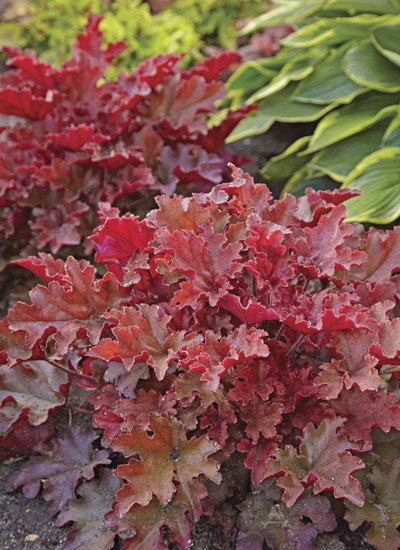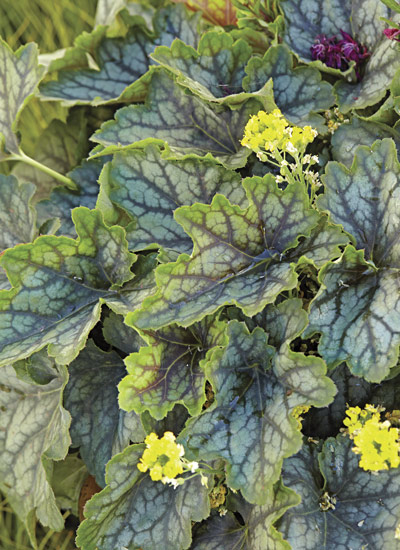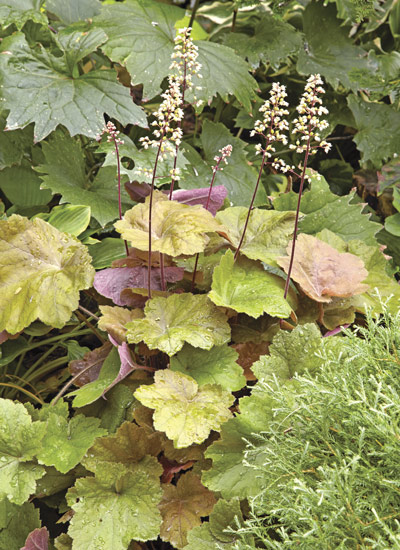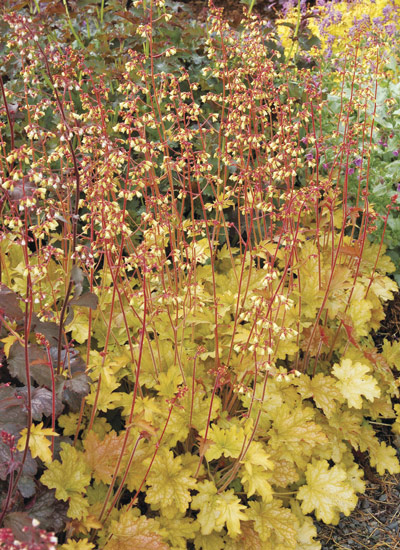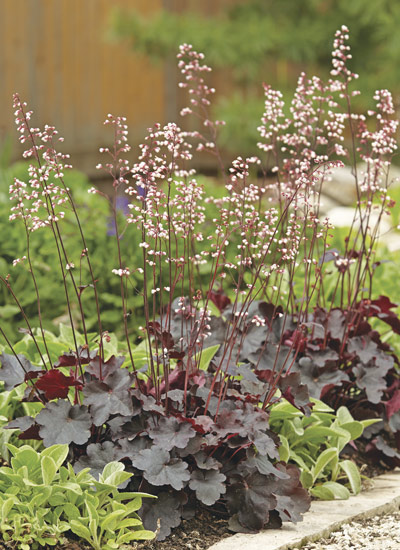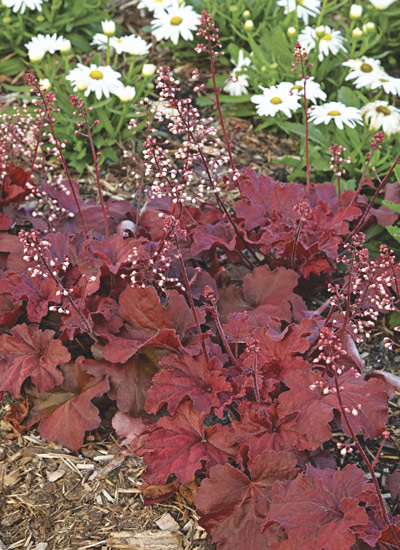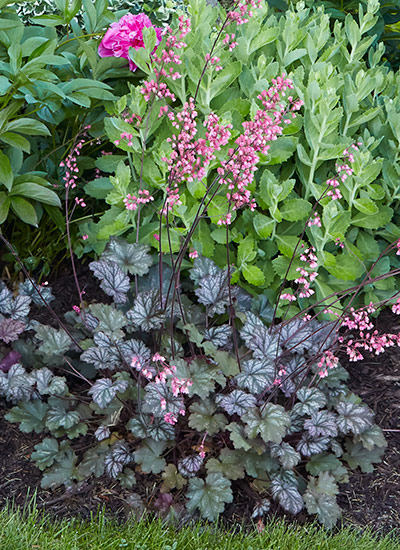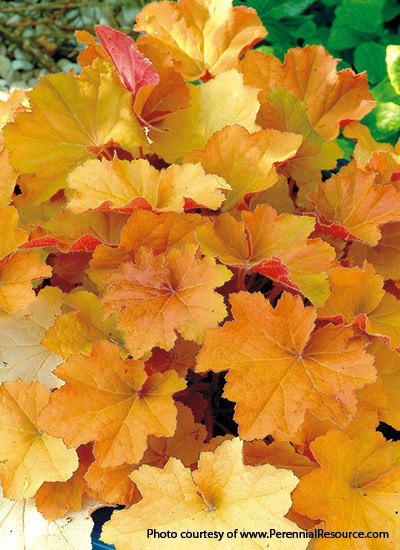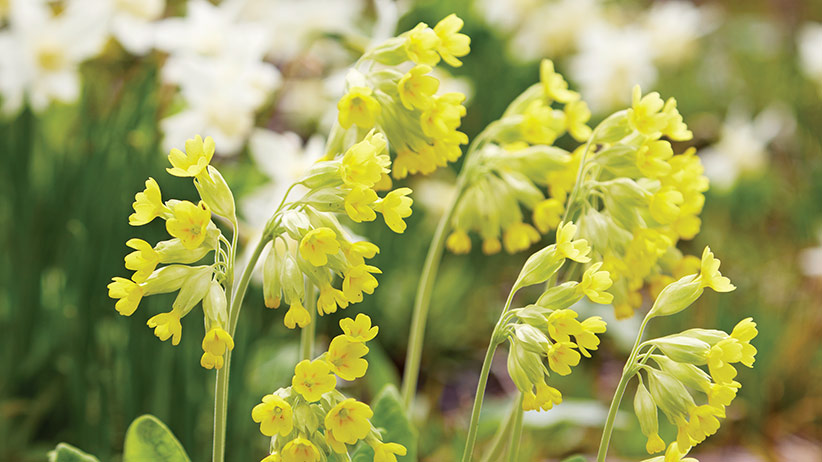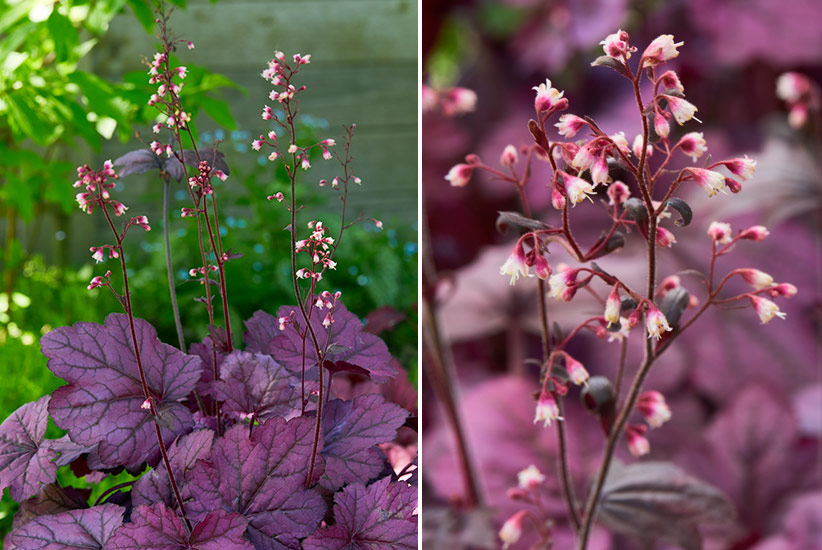
Add coral bells to your garden!
Could any plant be more versatile in the garden than coral bells? Sun or shade, it’s hard to beat this easy-care perennial. With a rainbow of available foliage colors, almost anyone should be able to find one (or several!) to blend into the garden.
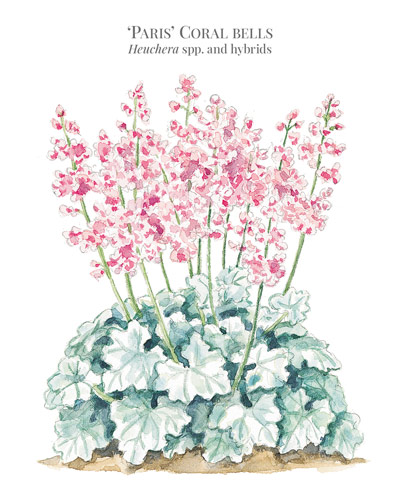
Coral bells Heuchera spp. and hybrids
Type Perennial
Blooms Tiny, bell-shaped flowers in shades of red, pink, green, coral or white in late spring to fall
Light Full sun to part shade
Soil Moist, well-drained
Pests None serious
Size 6 to 24 in. tall (up to 36 in. in bloom), 10 to 36 in. wide
Cold hardy USDA zones 3 to 9
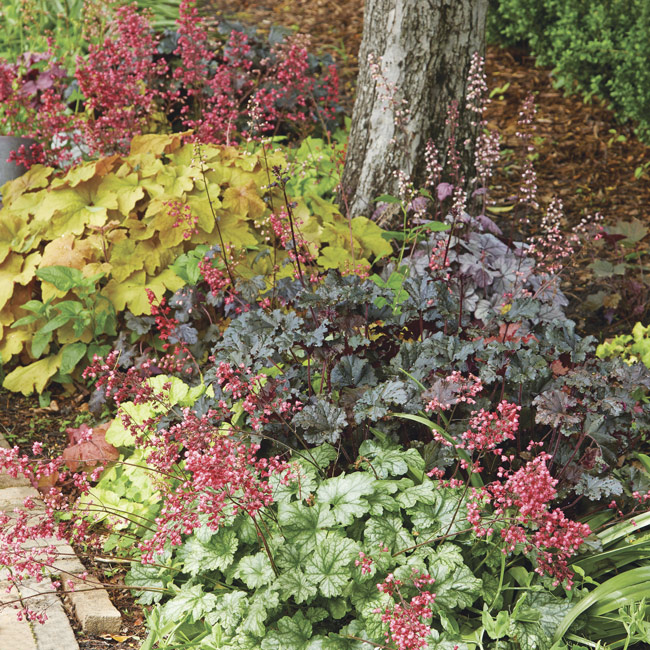
Coral bells are all about the foliage
Once upon a time, coral bells were simply mounds of green foliage with thin wands of coral-pink blooms. Now you can find this perennial in shades of green, chartreuse, amber, peach, orange, red, bronze and purple. And although there are plenty of bold solid-colored varieties, such as ‘Caramel’ and ‘Black Pearl’ in the photo above, breeders have also developed foliage with intricate vein patterns and lacy or metallic-looking overlays, as you can see on ‘Green Spice.’ All of this exciting variety makes a plant geek like me want one of each kind.
Light and airy blooms, too
Flowers are not usually as showy as the foliage, but the spikes of dainty blossoms serve to accent the eye-catching leaves without stealing their thunder. The tiny bell-shaped blooms dangling from tall spires can be red, pink, green, coral or white, and attract hummingbirds and other pollinators to the garden.
While coral bells breeding programs have mostly concentrated on unique foliage, Chuck Pavlich from Terra Nova Nurseries, a company that’s led the way on introducing new coral bells varieties, tells us to watch for showier blossoms in the future. And with good reason: The blooms make super cut flowers — and the foliage holds up like a champ in bouquets, too.
Did you know coral bells have native roots?
Coral bells species are native to North America, growing in a variety of climates, from moist, shady woodlands to dry, sunny regions. That’s what makes new hybrids of these species so adaptable to every garden. Hybrids with Southern native Heuchera villosa, such as ‘Fire Alarm,’ in the parentage will have increased heat and drought tolerance, while the Northern Exposure™ series bred from Northern native H. richardsonii are more cold-tolerant. Keep reading to learn how to use all of these exciting plants in your garden.
You Might Also Like:
Book: "The Garden Idea Book, Volume 1"
Best New Perennials for Shade
How to Get Rid of Slugs in Your Garden
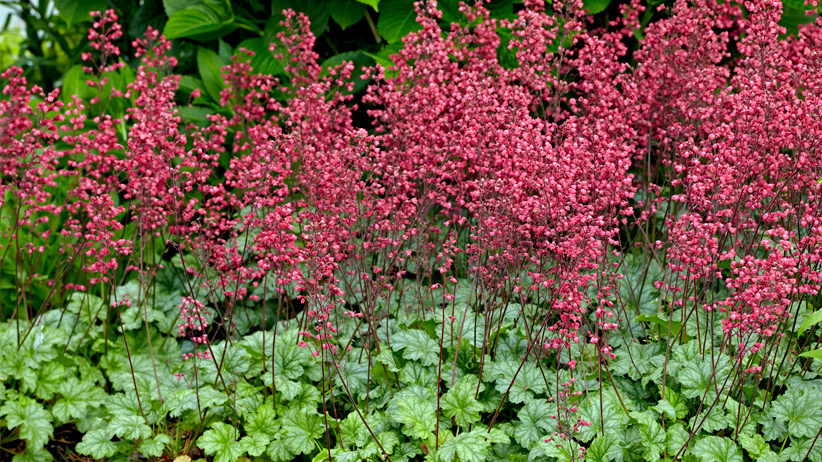
Designing with coral bells in the garden
Once you finally choose which beautiful coral bells to buy, the next trick is to decide where to plant it! Fortunately, that’s easy, since they can perform any number of roles in the garden.
Use coral bells along a pathway
Low-growing, colorful foliage makes coral bells ideal to grow along a path or the edge of the garden to soften the lines between the bed and a walkway or lawn. You won’t have to worry about the plants flopping over into the path, as they’ll stay put in a neat row.
Coral bells’ full, mounded habit makes them perfect to tuck under larger perennials or shrubs that suffer from “bare legs,” such as lilies, peonies or inkberry, to fill in the empty space between the exposed stems and the ground. Look for cultivars that rebloom, such as petite ‘Paris’, for a long-lasting front-of-the-border show that won’t quit. Growing 7 inches tall and 14 inches wide, ‘Paris’ continually flowers from early summer to frost in USDA zones 4 to 9. Its rose-colored flowers stand 14 inches tall, floating above minty green leaves with a white overlay.

Use coral bells foliage to catch attention in the garden
See how a chartreuse coral bells plant warms and brightens the border in the photo above? Foliage in shades of lime, yellow, peach or even silver provide a welcome light in a shady spot. Add a bit more color with the red-veined, yellow-green leaves of ‘Electric Lime’ for an interesting focal point.
Conversely, a dark-colored coral bells, such as near-black ‘Obsidian,’ tends to recede in a shady location, looking like a hole or gap in the bed from a distance. Instead, plant red, orange and purple coral bells in the sun, where they’ll look most vibrant, and eye-catching.
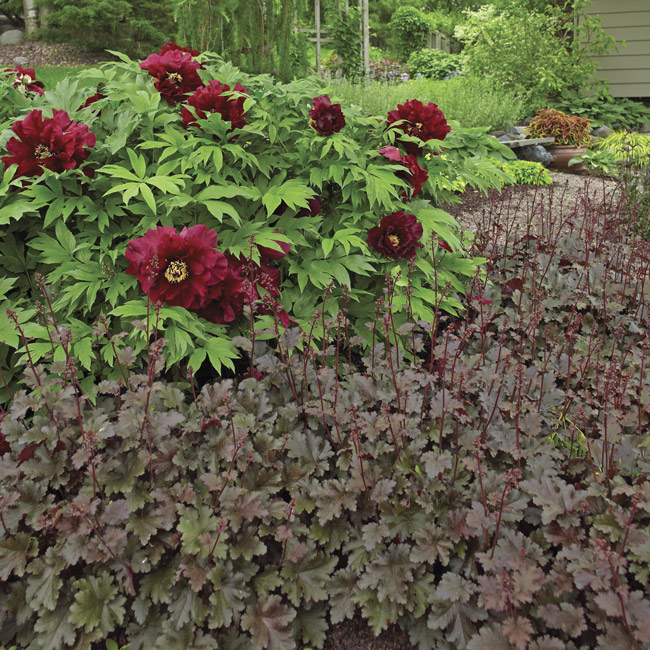
Use coral bells in a mass planting for impact
One coral bells plant is a focal point. A cluster of three or five can be the backbone of a bed. But a mass planting is a sight to behold. Just look at the sea of coral bells highlighting the tree peony pictured above.
Grown as a ground cover, large drifts of coral bells can provide low-maintenance color all season, and their tight habit has good weed-suppressing qualities. Taller varieties, like 12-inch-tall ‘Palace Purple’, fill in a roomy space with ease. For a mass planting, plant the coral bells half the mature width apart so they overlap and grow together quickly.
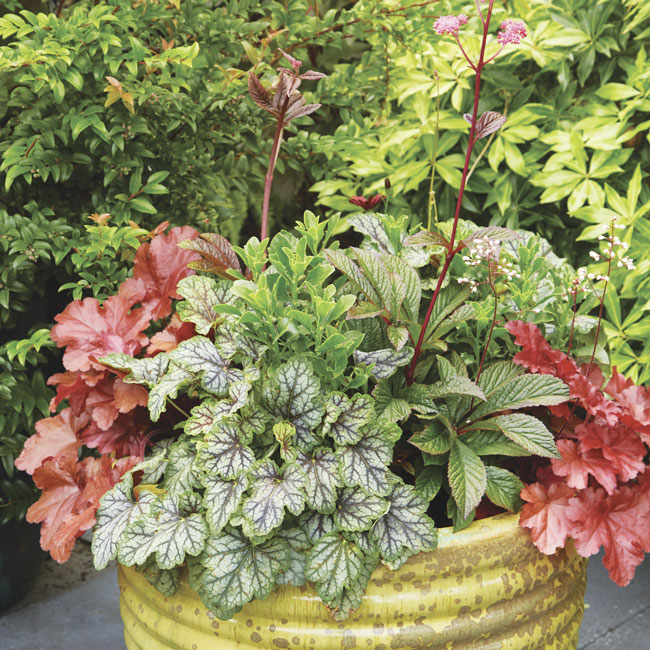
Add coral bells to container plantings
Coral bells are the perfect colorful foliage filler for a container, too. Their polite mound provides form and texture without becoming unruly, and you’ll even get blooms for an additional pop of color. Plant with other perennials, such as the rodgersia in the photo above, add to a container of annuals, or have a single coral bells as a specimen plant in its own pot to tie the garden in with the patio containers.
Overwintering coral bells
In zone 6 or warmer where coral bells is reliably evergreen, plants can be overwintered right in their containers. In colder zones, dig them up before a killing frost and plant them in the garden to get them through winter more reliably.
Try coral bells as a houseplant!
Did you know you could grow coral bells as a houseplant? Terra Nova’s Chuck Pavlich says any coral bells, especially the dwarf varieties like the Little Cuties™ series, will thrive indoors in a sunny window. But note that without a cold period, they may not bloom indoors, so just enjoy the fabulous foliage color.
You Might Also Like:
Shade Garden Design Tips
Video: Powerhouse Shade Plants for the Garden
Garden Gate's Best Hostas
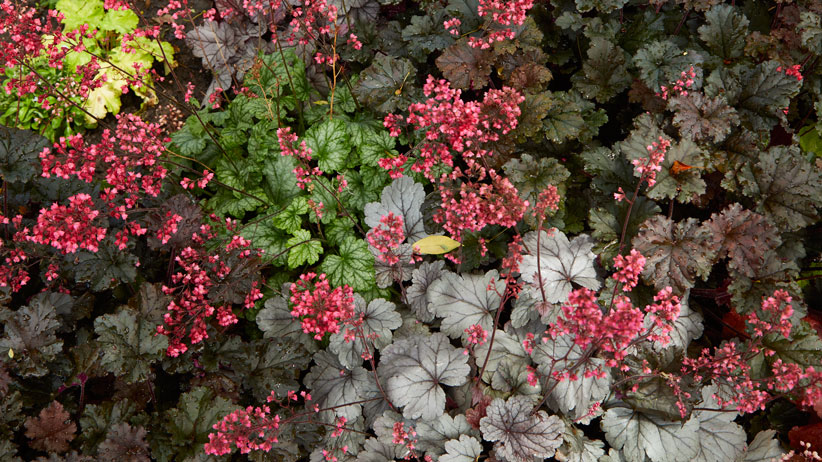
How to grow great coral bells
These adaptable plants can grow in sun or shade, but a general rule of thumb is that darker leaf colors are more sun tolerant than light or green cultivars. Also, leaves that are coarse or a bit hairy are more heat tolerant than those with shiny or metallic-colored leaves. But in hot Southern gardens, even coral bells that like sun appreciate a couple hours of light shade in the heat of the day, or their leaves can scorch.
Water wisely
Coral bells prefer well-drained soil, and many are drought tolerant. New varieties are often rust-resistant, but to avoid this fungal disease, be sure to water at soil level early in the day to keep foliage dry.
Winter care for coral bells
In cold zones, coral bells are prone to heaving, meaning their shallow root system is pushed upward as soil freezes and thaws during extreme winter temperature fluctuations, leaving roots exposed to bitter cold and potential damage. Help prevent heaving by mulching in late fall with a 2- to 3-inch layer of shredded bark, compost or straw.
If your plant does heave up, in late winter or very early spring, simply use your foot and gently push the crown down (it’s OK — Chuck says it wont hurt the plant), pressing it back into the ground. Then tuck in soil or mulch around it.
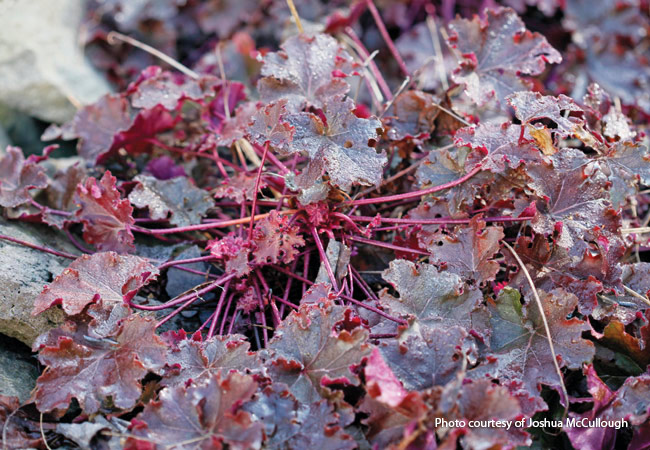
How to clean up coral bells in spring
Plants are evergreen where temperatures rarely dip below freezing, but leaves may appear flattened by spring, as the photo above shows. A bit of trimming will tidy them up. In zones 5 and colder, leaves will mostly die back in winter. As new growth emerges in spring, cut dead foliage back to within an inch of the ground and pull mulch away from the crown to prevent wet conditions that can cause root rot. Chuck recommends applying a low-nitrogen, slow-release fertilizer in early spring.

How to divide coral bells to get more plants
Over time, coral bells plants elongate on woody stems, collapsing in the middle and forming new crowns on side shoots that often aren’t even in the ground. Once this begins, usually every 2 to 3 years, dig up the plant and divide it.
Step 1: Dig up coral bells plant
Dig up the plant in late fall while the ground is still warm or early spring before new growth begins. Shake or brush the soil away to reveal shoots growing off the main crown that will become divisions.
Step 2: Split plant into divisions
Break apart or use sharp pruners to cut stems and trim off old, woody roots that don’t have any new growth. Keep divisions that have a few new roots forming along the stem to replant.
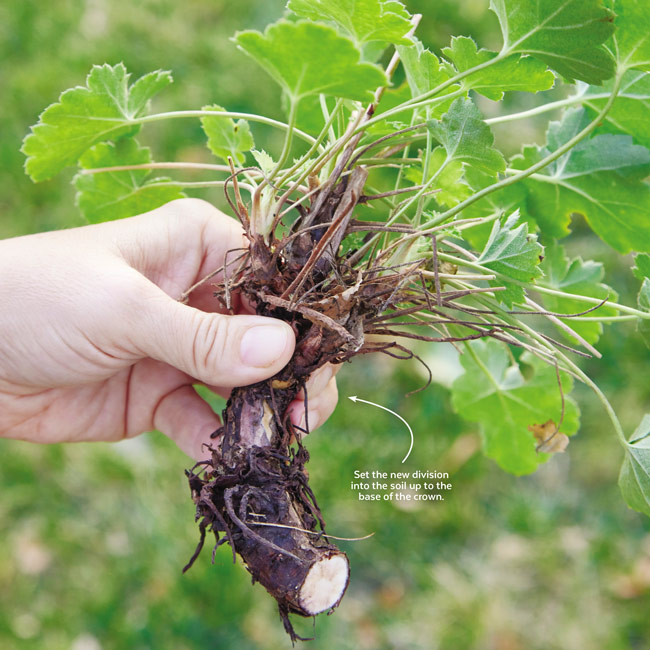
Step 3: Plant coral bells divisions
Plant the new stem division into the soil just below the crown. Even if it doesn’t have roots to start, it will grow, just like a stem cutting would. Be sure to keep new divisions moist for a few weeks to help establish roots.
You Might Also Like:
How to Divide 45 Favorite Perennials
Show Off Your Love of Plants with Garden Gate Apparel
Stroll Through a Southern Shade Garden
Find the perfect coral bells variety for your garden
Check out the gallery below to see some of our favorite coral bells cultivars. There’s bound to be one perfect for your garden!



